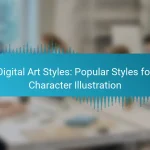Digital art techniques for character design play a crucial role in enhancing creativity and precision, enabling artists to craft unique characters that engage audiences through visual storytelling. Choosing the right illustration style is essential, as it helps convey the intended message and resonates with viewers. Utilizing effective tools like Adobe Photoshop, Procreate, and Clip Studio Paint can further elevate the character design process, providing artists with the flexibility and features needed to bring their visions to life.
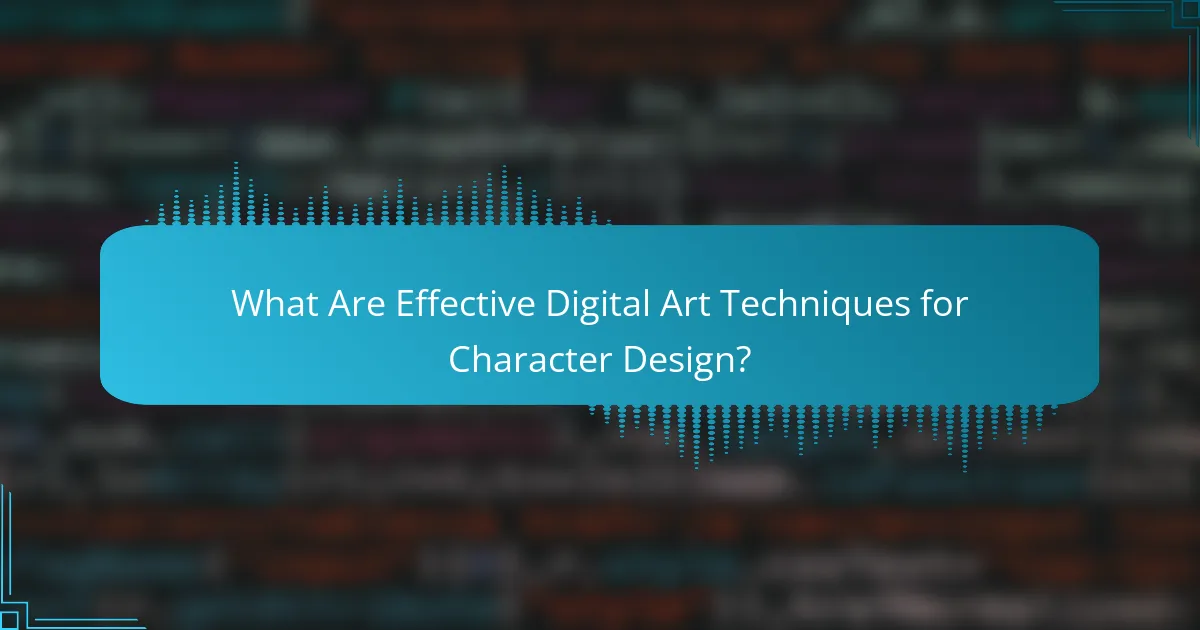
What Are Effective Digital Art Techniques for Character Design?
Effective digital art techniques for character design include various methods that enhance creativity and precision. These techniques allow artists to create unique characters that resonate with audiences through visual storytelling.
3D Modeling
3D modeling involves creating three-dimensional representations of characters using software like Blender or Maya. This technique allows for intricate details and realistic textures, making characters appear lifelike. Artists should consider the balance between polygon count and detail to optimize performance, especially for games or animations.
Common pitfalls include overcomplicating models, which can lead to longer rendering times. A good practice is to start with low-poly models and gradually add details as needed.
Digital Painting
Digital painting is a technique that mimics traditional painting using digital tools such as Photoshop or Procreate. It allows for a wide range of styles, from realistic to abstract, giving artists the freedom to express their vision. Layering is crucial in this process, as it enables adjustments without affecting the entire piece.
Artists should experiment with brushes and textures to find their unique style. Regularly saving work and using shortcuts can significantly enhance efficiency during the painting process.
Vector Art
Vector art uses mathematical equations to create images that can be scaled without losing quality, making it ideal for character design in logos or animations. Software like Adobe Illustrator is commonly used for this technique. Artists should focus on clean lines and shapes to maintain clarity at any size.
A key advantage of vector art is its versatility, but it may lack the depth and texture found in raster images. It’s essential to understand the limitations and strengths of vector graphics when choosing this method.
Pixel Art
Pixel art is a digital art form where images are created through the placement of individual pixels, often resulting in a retro aesthetic. This technique is popular in indie games and mobile applications. Artists should pay attention to color palettes and grid systems to maintain consistency and clarity.
While pixel art can be simpler to create, it requires a keen eye for detail. Limiting the color palette can enhance the visual impact and make the design process more manageable.
Mixed Media
Mixed media combines various digital techniques, such as photography, painting, and 3D elements, to create unique character designs. This approach allows for greater creativity and experimentation, as artists can blend styles to achieve distinct results. Software like Corel Painter can facilitate this technique.
When using mixed media, it’s important to maintain a cohesive style. Artists should consider how different elements interact and ensure that they complement each other rather than clash. Regularly reviewing the overall composition can help refine the final piece.
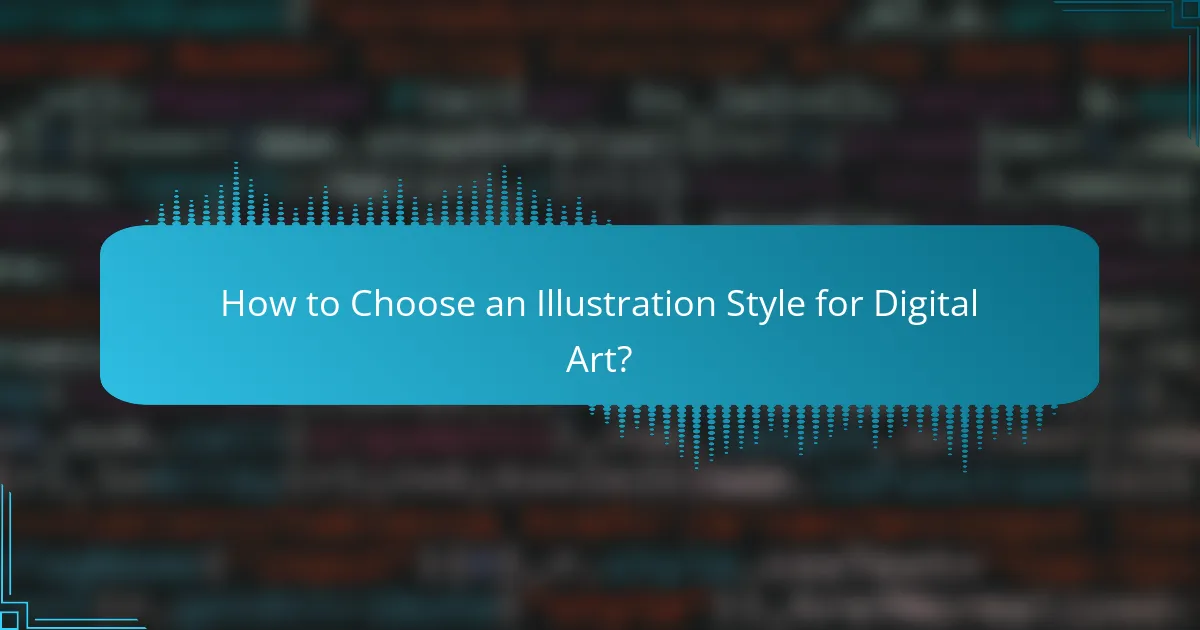
How to Choose an Illustration Style for Digital Art?
Selecting an illustration style for digital art involves understanding the intended message and the audience’s preferences. A well-chosen style enhances the artwork’s effectiveness and connects with viewers on a deeper level.
Consider Target Audience
Your target audience significantly influences the choice of illustration style. For instance, a playful, cartoonish style may resonate well with children, while a more sophisticated, minimalist approach might appeal to adults. Understanding demographics, interests, and cultural backgrounds will guide your style selection.
Conducting surveys or gathering feedback from potential viewers can provide insights into their preferences. This can help you tailor your illustration style to meet their expectations and enhance engagement.
Assess Project Requirements
Each project has unique requirements that can dictate the illustration style. Consider the purpose of the artwork, whether it’s for marketing, storytelling, or educational purposes. For example, a vibrant, dynamic style may be suitable for a promotional campaign, while a detailed, realistic style might be better for an educational book.
Additionally, evaluate the medium where the artwork will be displayed. Digital platforms may allow for more intricate styles, while print may require simpler designs to ensure clarity. Always align your style with the project’s goals and constraints.
Evaluate Personal Style
Your personal artistic style is a crucial factor in choosing an illustration style. It reflects your unique voice and can differentiate your work from others. Consider what styles you naturally gravitate towards and how they align with your artistic strengths.
Experimenting with various styles can help you discover what feels authentic while still meeting project and audience needs. Balancing personal expression with external requirements will lead to more satisfying and impactful artwork.
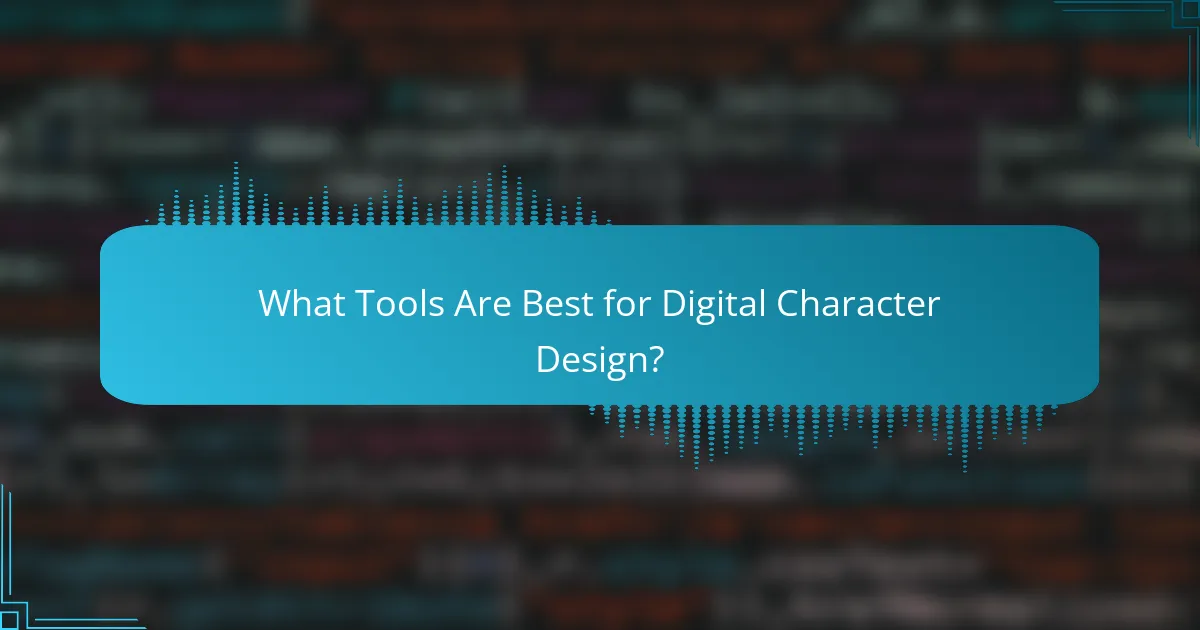
What Tools Are Best for Digital Character Design?
The best tools for digital character design include software that offers flexibility, a variety of features, and user-friendly interfaces. Popular choices among artists are Adobe Photoshop, Procreate, Clip Studio Paint, and Blender, each catering to different aspects of character design.
Adobe Photoshop
Adobe Photoshop is a versatile tool favored for its extensive range of brushes and editing capabilities. It allows artists to create detailed character designs with layers, blending modes, and advanced color correction features. The software is suitable for both 2D illustrations and concept art.
When using Photoshop, take advantage of customizable brushes to achieve unique textures and styles. Be mindful of the learning curve; beginners may find it overwhelming, but numerous tutorials are available to ease the process.
Procreate
Procreate is a popular choice for iPad users, known for its intuitive interface and powerful features. It offers a wide selection of brushes and tools specifically designed for character design, making it ideal for artists who prefer drawing directly on a touchscreen. The app supports high-resolution canvases, allowing for intricate details.
To maximize Procreate’s potential, explore its animation features and time-lapse recording options. These can enhance your workflow and provide insights into your creative process. Keep in mind that Procreate is exclusively available on iOS devices.
Clip Studio Paint
Clip Studio Paint is tailored for comic and manga artists, offering specialized features for character design and illustration. It includes vector layers, 3D models for reference, and a vast library of brushes. This software excels in line art and coloring, making it a strong contender for character designers.
Utilize the 3D model feature to pose characters and experiment with angles before finalizing your design. Clip Studio Paint also supports animation, which can be beneficial for artists looking to create dynamic character movements.
Blender
Blender is a powerful open-source 3D modeling software that is increasingly used for character design. It allows artists to create fully realized 3D characters, complete with rigging and animation capabilities. Blender’s extensive features make it suitable for both beginners and experienced 3D artists.
When starting with Blender, focus on mastering the basics of modeling and sculpting. The software has a steep learning curve, but numerous online resources and community support can help you along the way. Consider using Blender for character design if you aim to create animated content or game assets.
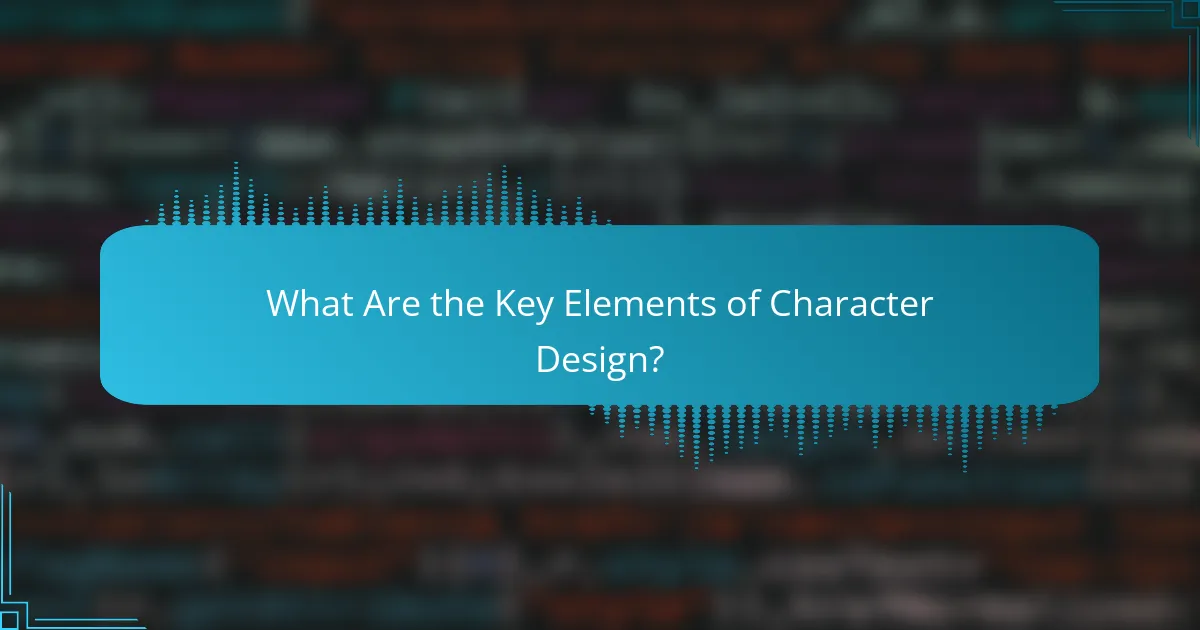
What Are the Key Elements of Character Design?
Character design involves several essential elements that contribute to creating memorable and visually appealing characters. Key elements include silhouette, color palette, and facial expressions, each playing a crucial role in conveying personality and emotion.
Silhouette
The silhouette of a character is the overall shape and outline that defines its form. A strong silhouette makes a character easily recognizable and distinct, even in a simplified view. Aim for unique shapes that reflect the character’s traits; for example, a tall, angular silhouette may suggest a villain, while a round, soft shape might indicate a friendly character.
When designing silhouettes, consider using negative space effectively. This can enhance the character’s visual impact and help differentiate them from others. Experiment with various poses and proportions to find the most striking silhouette that aligns with the character’s personality.
Color Palette
The color palette is vital in character design as it influences the audience’s perception and emotional response. Colors can evoke feelings and convey traits; for instance, warm colors like red and orange can suggest energy or aggression, while cool colors like blue and green often imply calmness or stability. Choose a limited palette to maintain cohesion and ensure the character stands out.
When selecting colors, consider cultural associations and the context of the character’s environment. For example, a character in a fantasy setting may benefit from vibrant, unconventional colors, while a character in a realistic setting might require more subdued tones. Test combinations to see how they interact and adjust based on the character’s role in the story.
Facial Expressions
Facial expressions are crucial for conveying emotions and personality in character design. They can communicate a wide range of feelings, from joy to anger, and help the audience connect with the character. Focus on the key features of the face, such as the eyes, mouth, and eyebrows, to create expressive and relatable expressions.
To enhance the effectiveness of facial expressions, study real-life references and observe how emotions manifest physically. Practice drawing various expressions to understand the subtleties involved. Additionally, consider the character’s personality; a shy character may have more subdued expressions, while an outgoing character might display more exaggerated emotions.
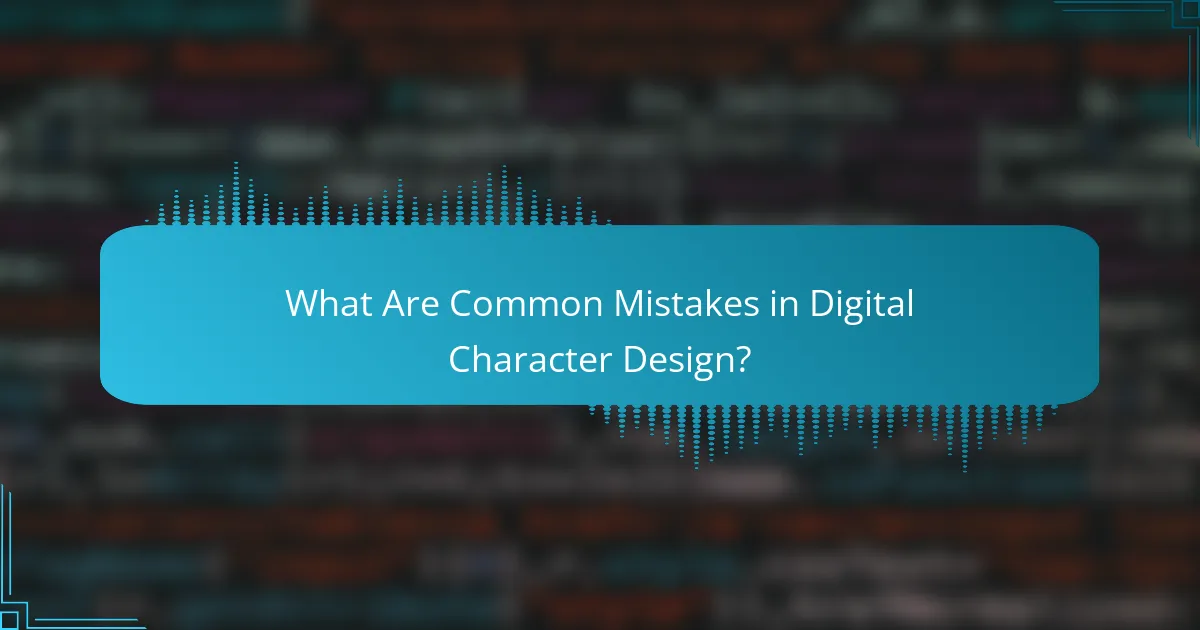
What Are Common Mistakes in Digital Character Design?
Common mistakes in digital character design include poor proportions and a lack of consistency. These issues can lead to characters that appear awkward or unprofessional, negatively impacting the overall quality of the artwork.
Poor Proportions
Poor proportions can make characters look unrealistic or unappealing. When designing a character, it’s crucial to maintain a balance between different body parts, such as the head, torso, and limbs. For example, a character with an oversized head compared to a small body may seem cartoonish, while exaggerated features can enhance stylization if done correctly.
To avoid proportion issues, use reference images and study anatomy. A common guideline is the “eight heads tall” rule for human figures, which helps maintain realistic proportions. Regularly checking your character against these standards can prevent significant errors early in the design process.
Lack of Consistency
A lack of consistency in character design can confuse viewers and dilute the character’s identity. Consistency refers to maintaining the same style, color palette, and design elements throughout the character’s appearance. For instance, if a character has bright blue hair in one scene but dark brown in another, it can disrupt the visual narrative.
To ensure consistency, create a character sheet that outlines key features, colors, and expressions. This reference can help maintain uniformity across different poses and scenes. Additionally, regularly revisiting your character sheet during the design process can help catch inconsistencies before they become ingrained in your work.


